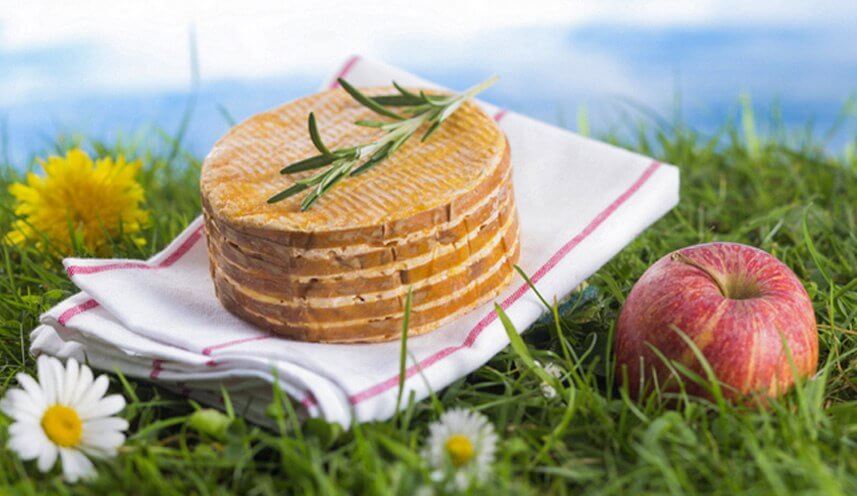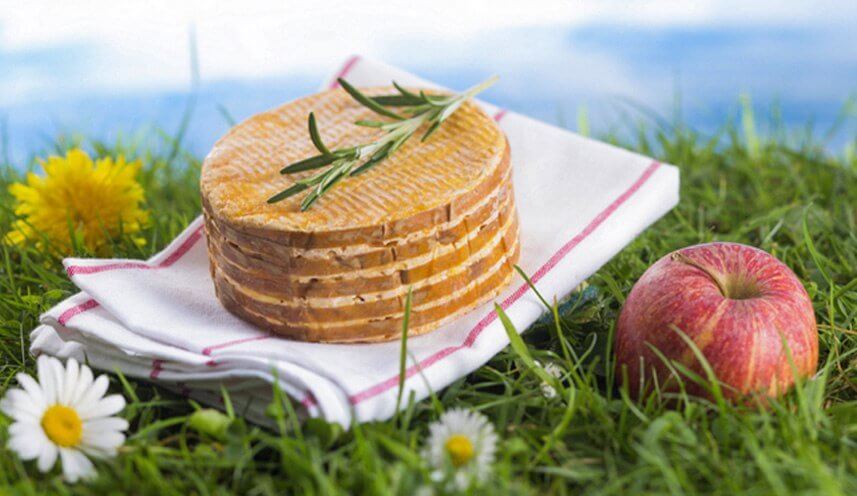
Livarot Cheese Making Recipe
-
Yield
3 Pounds
-
Aging Time
~3 Months
-
Skill Level
Advanced
-
Author
Jim Wallace

Livarot Cheese Making Recipe Info
Livarot: A Bold Cheese from Normandy
What Makes Livarot Unique
History of Livarot
Making Livarot Cheese
Ingredients
Total price for selected items: Total price:
Instructions
A Guideline for Making Livarot Cheese
To stay true to the original format for this cheese, which is somewhat higher and wider than a Camembert, I make a double batch from 3 gallons of milk. You can easily reduce it to a 2 gallon batch by reducing the culture and rennet proportionately.
-

Heat & Acidify Milk
Begin by heating the milk to 86F (30C). You can do this by placing the milk in a pot or sink of very warm water. If you do this in a pot on the stove make sure you heat the milk slowly and stir it well as it heats. Using a store bought pasteurized milk is fine, but for this batch I used a Jersey milk at about 5% fat and skimmed it after holding overnight to about 3% fat. Traditionally, the milk was allowed to rest overnight and the cream skimmed for butter (I used my cream for cream cheese).
Once the milk reaches 86F the culture, geotrichum and b. linens can be added. NOTE: The MA 4002 culture is more traditional and offers late ripening affects from the Thermophilic and tends to be a bit creamier than the C101 Mesophilic Culture packs.
To prevent the powder from caking and sinking in clumps, sprinkle the powder over the surface of the milk and then allow about 2 minutes for the powder to re-hydrate before stirring it in. The milk now needs to be kept at this target temperature until it is time to increase for cooking the curds. Hold the milk with culture added quiet for the next 60 minutes to allow the bacteria to begin doing its work. It will be very slow initially but will soon kick into its more rapid rate of converting lactose to lactic acid.
-


Coagulate with Rennet
Now it's time to add about 1.5ml of single strength liquid rennet. Stir it in gently for 1 min.
The milk now needs to sit quiet for about 75 minutes while the culture works and the rennet coagulates the curd. This is longer than many of the firmer cheeses but will help to hold more moisture in the finished cheese. You should note that the milk begins to thicken at about 15-20 minutes.
The thermal mass of this milk should keep it warm during this period. It is OK if the temp drops a few degrees during this time but holding the pot of milk in a water bath will be helpful if kept at about a degree or 2 above the 86F.
During this time make sure you have sanitized and prepared the draining pan (colander) with its cloth as well as the final mold(s) to be used.
-




Cut the Curds
Once the curd has been firmed sufficiently, it is time to cut and drain before molding. To maintain the higher moisture in the final cheese the cut is large at about 3/4 inch. Do the best you can and some variation in curd size is acceptable but please, neither whales nor tiny curd bits... things will not go well if that happens.
Make sure you check the firmness of the curd before the cut, but with the extra time of setting this should be just fine unless you have a rennet that is not doing its job for some reason.
Begin the cut with vertical cuts and then use the flat ladle or spoon to break these horizontally don't forget to give the curds a rest before stirring.
Once the cut has been done, allow the curds to rest for about 5 min. for the cut surfaces to heal slightly. Following this a very gentle stir for another 5-10 minutes focusing on just keeping everything slowly moving but avoiding further size reduction is the goal. This will be a bit drier, than the curd going into molds for Camembert. If the curd temperature has dropped during coagulation and cutting they should be brought back to 86F at the start of the stir.
Once the curd has been dried slightly, allow them to settle to the bottom while you remove the whey down to just above the settled curds.
Your draining container and cloth should be ready to receive the curds. Transfer them carefully to the cloth covered container and allow the residual whey to drain for 5 minutes, but try to keep them from consolidating too much at this point.
-



Drain the Curds
For my draining container I use a coated wire kitchen drainer lined with the cloth. The larger surface area allows me to keep the curds more separated during the draining and keeps them from clumping together with gentle agitation. I also use this when making blues.
The dry curds can now be transferred to this drainer lined with butter muslin.
The curds should be allowed to drain for 30 minutes and a gentle stirring will make sure that the whey drains off.
-




Mold the Curds
Next begin transferring the drained curds to the molds once the draining whey has slowed. The curd should be well drained by now and already beginning to clump together.
For this guide I am using a tall mold M113 (also used for making some blues like Fourme D'Ambert).
By placing all of the curds into this I make a taller cheese without needing any weight. I cut this in half after it consolidates, hence my double batch. If using the SmallMold-M3 with follower, add about a 1-1.5 lb. weight to this for consolidation.
For proper draining I use our fine mesh draining mat set on top of a firm board (to make turning easier) and then the mold placed on top of this.
The curd can now be transferred to the mold and gently packed as you do this. The curd will need to continue draining overnight as the bacteria continue to work.
The curd continues its draining, note the single tears of whey coming from the mold here and the slow steady flow from the draining mat.
-




Forming the Cheese
There is really no press weight needed for this except when using the SmallMold-M3 forms as noted above (1-1.5lbs).
However it is important to:
- Keep the cheese at 70-75F for continued bacteria activity overnight.
- Flip the cheese at frequent intervals of 30 minutes and then tapering to every few hours until bedtime.
The next AM the cheese should be well consolidated and it should have reached its final acid development. It should have a mild acidity in tasting (no obvious sweetness from lactose).
Note how much the curd compresses itself in the mold during consolidation
At this point they can be removed from the molds. This is where I cut my double batch in half with a cheese wire.
The cheese can then be moved to the salting area (ideally 55-60F and 70-75% moisture) but do the best you can.
-


Binding & Salting
Since the cheese has such a high moisture, the body will soften during aging and, unless it is contained, will tend to spread. To avoid this, the cheese was traditionally wrapped in reeds that had been split into small strands. 5 wraps around the cheese were traditional (stripes of the 'Colonel') . Here I use strips of Raffia that have been boiled and soaked in brine.
For this cheese I prefer to dry salt using 1.25 tsp of medium grain salt per side. Apply this to the top surface, spreading evenly, and then pat evenly around the sides. The sides get less salt but they will be done twice. The salt will tend to pull more moisture from the cheese over the next few days
Allow this salt to dissolve and form a brine, then be absorbed by the cheese body.
At the end of the dry salt, allow the cheese to absorb the salt and dry until the next day and then repeat for the other surface.
When finished leave the cheese in the salting area. The relative warmth here will promote the growth of natural ambient yeast (its everywhere) to start the rind development.
-




Aging
For the development of the washed rind, I have recently done a complete "How To" for the Esrom Cheese. For the details that pretty much apply here as well. Go to the Esrom Page then down to the AGING topic for more on the details of how to develop the washed rind. The cheese needs to be allowed to develop at about 56-60F and kept very moist for the initial yeast to develop. If the surface dries prematurely, the proper multi-culture surface will be inhibited. Moist but not too moist, that's the tricky part of washed rinds. Just tacky but not swampy is what you need for success
I keep the surface moist for the first few days by keeping covered with a moist draining cloth. This cloth can be removed after about 2-3 days once you feel the greasy surface indicating the yeast is working. You will also note a rather fruity smell (apple/pear).
At about 7-12 days you should note a drying off of the greasy rind and a slight white dusting of mold growth. This is the stage where the geotrichum begins to work. You can wash this back and control it with the light brine washing.
Following this first wash the cheese can be moved to the aging space at 52-54F and moisture of 92-95% (a plastic box and cover should have no trouble keeping the moisture).
Notice how the strips of raffia are holding in the cheese as it ripens and how the curd desperately wants to escape its bindings.
Successive washes should be done every 3 -5 days as the new molds appear. Wash one surface and side at a time and let dry before returning to the cave. Wait a day before doing the other side.
It should gradually develop that typical rosy character of a washed rind by 2 weeks.
By 2-3 weeks you should have a nice washed rind beginning to develop its color and aroma that can be easily maintained with a light wash periodically.
The cheese now needs to be maintained for the next 2-3 months (or longer) with occasional light brine wipes.
Cheese Making Supplies
Related Products
You May Also Like


































